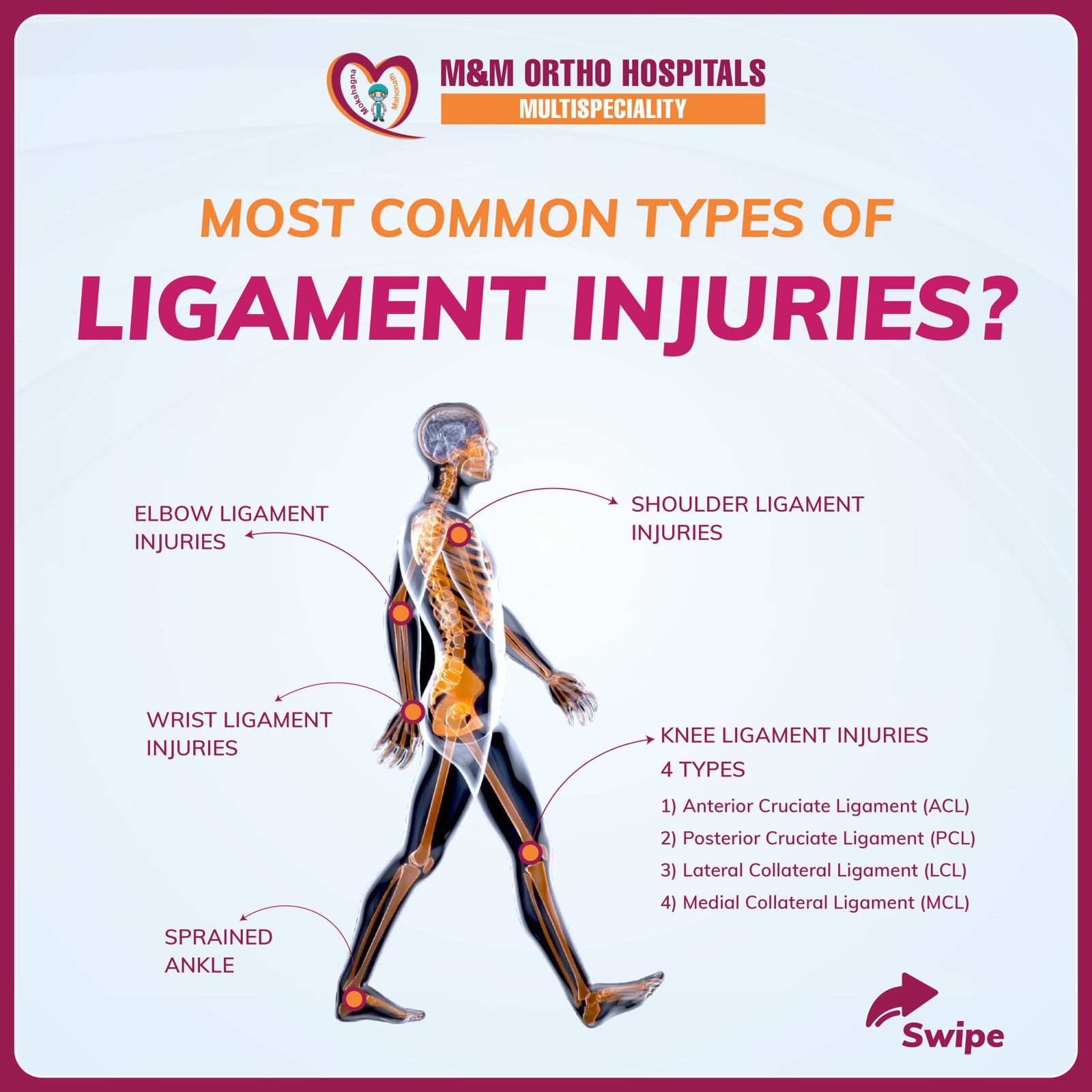Ligament injuries are among the most common musculoskeletal issues, particularly in individuals who engage in physical activities, sports, or manual labor. Ligaments are tough, fibrous tissues that connect bones to each other, stabilizing the joints and allowing for controlled movement. When subjected to excessive force, sudden twists, or improper use, these ligaments can stretch or tear, leading to painful injuries and joint instability.
This blog will provide a comprehensive overview of the most common types of ligament injuries that affect various joints, their symptoms, and potential treatments.
1. Knee Ligament Injuries
Knee ligament injuries are particularly common among athletes and individuals involved in physical activities. The knee joint has four primary ligaments that help stabilize it:
A) Anterior Cruciate Ligament (ACL) Injury
The ACL, located in the center of the knee, prevents the shin bone (tibia) from sliding forward. ACL tears are common in sports involving sudden stops, pivots, or jumps.
Symptoms:
- Popping sound at the time of injury
- Severe pain and swelling
- Knee instability
B) Posterior Cruciate Ligament (PCL) Injury
The PCL, located at the back of the knee, prevents the tibia from moving backward. PCL injuries often result from direct blows to the knee, such as during car accidents or falls.
Symptoms:
- Pain and swelling at the back of the knee
- Difficulty walking or bearing weight
C) Lateral Collateral Ligament (LCL) Injury
The LCL stabilizes the outer part of the knee. Injuries occur due to blows or excessive force on the inner knee.
Symptoms:
- Pain on the outer knee
- Swelling and tenderness
- Difficulty with lateral movements
D) Medial Collateral Ligament (MCL) Injury
The MCL stabilizes the inner knee and is often injured during activities that cause the knee to bend inward excessively.
Symptoms:
- Pain and swelling on the inner knee
- Difficulty extending the knee
Treatment for Knee Ligament Injuries:
Mild injuries may heal with rest, bracing, and physiotherapy. Severe tears, such as ACL injuries, often require ligament reconstruction surgery.
2. Shoulder Ligament Injuries
The shoulder is one of the most mobile joints in the body, making it susceptible to ligament injuries, particularly during overhead activities, sports, or falls.
Common Shoulder Ligament Injuries:
Rotator Cuff Tears:
- The rotator cuff consists of four muscles and their tendons, which help stabilize and move the shoulder joint. Overuse or sudden trauma can cause these structures to tear partially or completely.
Infraspinatus and Subscapularis Injuries
- These are key rotator cuff muscles that contribute to the stability of the shoulder joint.
- Injuries can result from overuse, falls, or sudden impacts.
Teres Minor Injuries
- The teres minor muscle helps with external rotation and shoulder stability.
- Damage often occurs in athletes involved in throwing sports.
Glenohumeral Ligament Injuries
- The glenohumeral ligament stabilizes the shoulder joint by preventing dislocation.
- Injuries may result from excessive overhead movements or trauma.
Acromioclavicular (AC) Joint Instability:
- Also called a shoulder separation, this occurs when the ligament connecting the clavicle to the acromion (part of the scapula) tears due to direct impact or falls.
Symptoms:
- Shoulder pain and weakness
- Limited range of motion
- Swelling or bruising around the joint
Treatment:
Treatment for shoulder ligament injuries may involve rest, physical therapy, or in severe cases, surgical intervention to repair torn ligaments and restore joint stability.
3. Sprained Ankle
Ankle sprains are one of the most common ligament injuries, often caused by twisting or rolling the ankle, which stretches or tears the supporting ligaments.
Types of Ankle Sprains:
- Lateral Ankle Sprain: Involves injury to the ligaments on the outer side of the ankle, particularly the anterior talofibular ligament (ATFL).
- Medial Ankle Sprain: Less common and involves the deltoid ligament on the inner ankle.
Symptoms:
- Pain, swelling, and bruising around the ankle
- Difficulty bearing weight
- Instability or stiffness in the joint
Treatment:
Rest, ice, compression, and elevation (R.I.C.E) are the initial treatment methods. Severe ligament tears may require immobilization, physical therapy, or surgery.
4. Elbow Ligament Injuries
Elbow injuries are common in athletes, especially those involved in throwing sports like cricket, baseball, or tennis.
Common Elbow Ligament Injuries:
- Ulnar Collateral Ligament (UCL) Injury: Repeated stress, such as throwing motions, can cause the UCL to tear. This condition is often referred to as “Tommy John Injury.”
- Lateral Collateral Ligament (LCL) Injury: This is less common but can occur due to elbow dislocations or trauma.
Symptoms:
- Pain on the inner or outer side of the elbow
- Difficulty gripping or throwing objects
- Swelling and instability of the elbow joint
Treatment:
Non-surgical options include rest, physical therapy, and bracing. Severe cases may require ligament reconstruction surgery.
5. Wrist Ligament Injuries
The wrist is a complex joint comprising multiple small bones and ligaments, making it prone to injury from falls or repetitive motions.
Common Wrist Ligament Injuries:
- Scapholunate Ligament Injury: This is one of the most commonly injured ligaments in the wrist, often caused by falls on an outstretched hand.
- Triangular Fibrocartilage Complex (TFCC) Tear: TFCC injuries affect the ligament and cartilage that stabilize the wrist’s ulnar side.
Symptoms:
- Pain and swelling in the wrist
- Weak grip strength
- Clicking or instability during wrist movement
Treatment:
Treatment may include immobilization with a splint or cast, physical therapy, and in some cases, surgical repair.
Conclusion
Ligament injuries are common but can significantly impact mobility and daily activities if not managed properly. From the shoulder to the ankle, ligaments play a crucial role in stabilizing joints and ensuring smooth movement. Early diagnosis and treatment are essential to prevent long-term complications such as joint instability or arthritis.
If you experience symptoms like pain, swelling, or difficulty moving a joint, consult an orthopedic specialist for proper evaluation and treatment. At M & M Ortho and Multispeciality Hospital, we provide comprehensive care for all types of ligament injuries, ensuring the best possible outcomes through advanced diagnostic tools, personalized treatment plans, and rehabilitation support.
Don’t ignore your ligament health! Seek expert advice to recover and return to an active lifestyle.
Need Help with a Ligament Injury?
Contact Dr. Madhu Reddy, the Best Orthopedic Doctor in Hyderabad, at M & M Ortho and Multispeciality Hospital for expert consultation and treatment.
Your Joint Health Matters!




